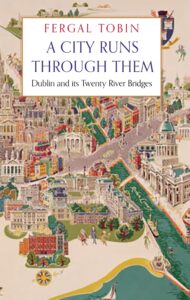
The late Fergal Tobin’s A City Runs Through Them ambitiously explores the urban evolution of central Dublin through its bridges.
Tobin adopts a conceptually intriguing approach, weaving the chronological development of Dublin with the construction and significance of its bridges. His narrative promises an insightful exploration of urban development, linking each bridge’s history with broader socio-economic transformations.
Tobin’s method of storytelling is sometimes engaging, blending engineering aspects with significant historical events and personal anecdotes related to the figures who planned, funded, and named or for which these bridges were named. The book is enriched with stories that provide context to the bridges at their inception, viewed from both a historical and a modern perspective.
However, despite its promising premise, the book faces challenges maintaining a consistent narrative. Tobin’s style fluctuates significantly; he sometimes adopts a conversational tone, addressing the reader directly with wit and sometimes snide remarks. This approach brings a personal touch to the narrative, although it can feel overly opinionated or divergent from the topic. His anecdotes, drawn from a mix of personal knowledge and research, sometimes veer off into tangents, leading the reader away from the central storyline before abruptly returning.
The structural choice of dividing the book into 22 chapters, each dedicated to a different bridge, potentially could allow readers the potential flexibility to dip in and out of the book – if the author did not seem slightly burdened with trying to keep to the broader narrative. In this, I think he could have done one or the other, but in striving to do both, it weakens each to the overall detriment. This format contributes to a sense of fragmentation, as the connections between chapters can seem tenuous. While each chapter is rich in detail and might be enjoyed individually, the overarching narrative thread that should bind them together is broken.
That’s me, though. An abundance of stories, many seeming unconnected to the broader promise and subject sometimes to the author’s opinions – the corruption of Haughey, “a politician who could not keep his sticky fingers out of the public till’. Or odd statements ‘I imagine the Duchess of Richmond, by then long in her own grave, was not impressed. But who cares?” – Well, not me. Too much trivia.
Moreover, Tobin’s inconsistent use of language—oscillating between an overly learned lexicon and colloquial expressions—was jarring rather than enriching. This stylistic inconsistency and numerous digressions undermine the book’s coherence and detract from my engagement.
Despite these critiques, the book does have its merits. It offers a wealth of historical detail and presents bridges as physical structures and pivotal elements in Dublin’s urban landscape. Certain chapters, like the one focusing on Rosie Hackett, effectively use the bridges as springboards to discuss larger themes, such as the development of the Dublin tram system.
In conclusion, while A City Runs Through Them is conceptually rich and full of potential, its execution wasn’t satisfactory due to its uneven narrative and stylistic inconsistencies. The book’s conclusion is indicative: Envoi. What a weird way to end a book. ‘Well, Wales actually.’ Weak, disjointed, and somewhat less than profound.
I would rate it as 4.5/10, acknowledging its strengths and shortcomings.
